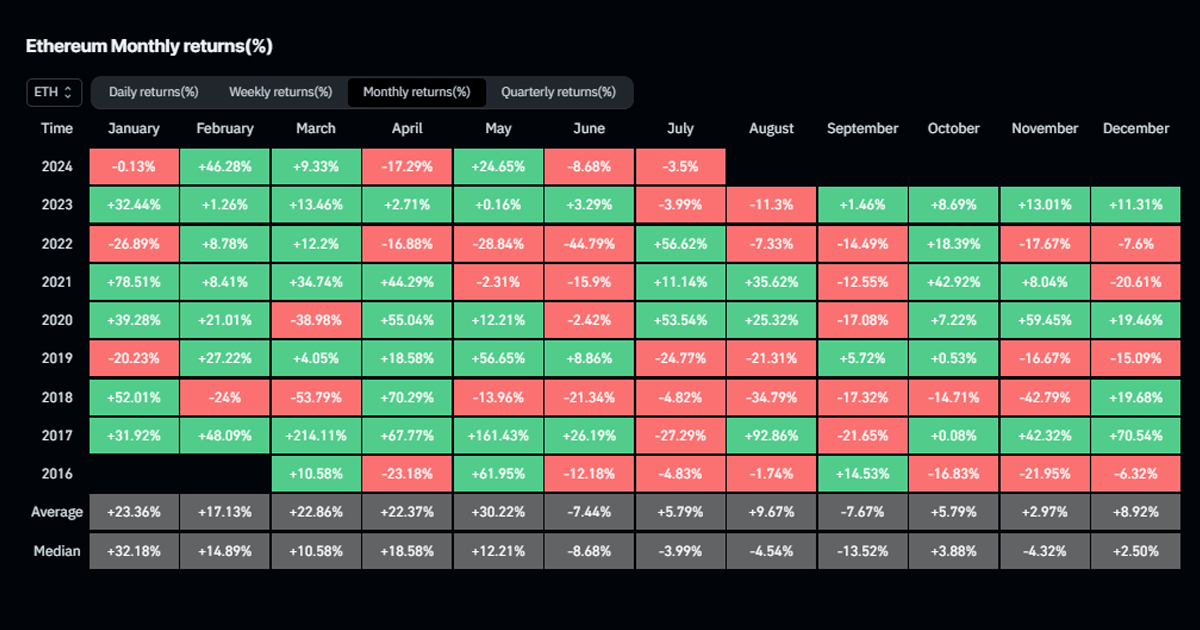Ethereum
Market Not Kind Toward ETFs or Ether Tokens as Volume Surpasses $1 Billion

Ether coin, the native token of the Ethereum blockchain, is based on gold coins similar to… [+] illustrate cybercurrencies.
Getty Images
It was really just a matter of time.
Just seven months after the first Bitcoin spot ETFs hit the market, the Securities and Exchange Commission (SEC) on Tuesday approved nine ETFs tracking the cryptocurrency Ether for trading. But the market hasn’t been kind to the new offerings, as they all posted significant losses in their first two days of trading.
Each ETF will track the spot price of Ether, the world’s second-largest cryptocurrency and the driving force behind the Ethereum blockchain. Total volume across the nine new ETFs topped $1.08 billion on their first day of trading, according to Bloomberg Intelligence.
“Bitcoin is considered a store of value and a way to transfer money from one party to another,” said Ric Edelman, founder of the Digital Assets Council of Financial Professionals. “Ethereum allows you to program the terms of that transfer, so the receiving party doesn’t receive your money until they fulfill their obligation, such as sending you the concert tickets you bought.”
The ability to program settlement terms allows Ethereum to function like an escrow account, but without human intermediaries, Edelman continued. This makes it faster, more secure, and cheaper, and can be used by virtually every industry in the world.
Despite the assumption that the price of Ether would rise on the day of the ETF launch, the market has not been kind to the token or the ETFs. Yesterday, Ethereum’s native token fell 1%. Today, Ether plunged 4.4%, falling below $3,400 to $3,322.33.
The decline could be the cliché of buying the rumor and selling the news. The early launch appears to have been priced into the market. Short-term investors may have taken advantage of the day to take profits. Today’s decline could be related to the S&P 500 and Nasdaq having their worst day since 2022
“This is a positive for the cryptocurrency industry in my opinion – some elements may go against the ethos of decentralized finance that Bitcoin and Ethereum were founded on – but ETFs don’t change the underlying assets or protocols,” said James Seyffart, a research analyst at Bloomberg Intelligence. “These ETFs are building bridges between Ethereum and traditional financial markets.”
These gateways make it possible to bring decentralized finance to a wider range of people and capital who are not allowed to buy real cryptocurrencies or who do not want to deal with the multi-layered process. The ETF structure also provides regulatory clarity and acceptance by federal regulators, such as the SEC.
“The launch of Ether spot ETFs is another step on the path to broader adoption of cryptocurrency,” said Nate Geraci, president of The ETF Store, a registered investment advisor that offers only ETFs.
The nine ETFs
In addition to the new ETFs, Grayscale Investments has received SEC approval to convert its Grayscale Ethereum Trust (ETHE) into a spot ETF. Having been open since 2017, ETHE has become the largest spot Ether ETF with $9.19 billion in assets under management as of July 23. On Tuesday, it was down 0.6% on the most volume of any Ether ETF, $463.2 million. Today, it is down 2.5% to $28.62. It still charges the same high expense ratio as a traditional trust, 2.5%.
The firm also launched a second “low-cost” fund, the Grayscale Ethereum Mini Trust (ETH), whose initial seed consists of 10% of ETHE’s underlying Ethereum, or about $1.02 billion. It started the day as the second-largest spot Ethereum ETF. On its first day of trading, it fell 0.9% to $3.27 on $63.8 million in volume. Today, it’s down 3% to $3.17. For the first six months of trading, the expense ratio will be 0%. After the six-month period, or when the fund reaches $2.0 billion in assets, the fee will be 0.15%.
Blackrock’s iShares Ethereum Trust (ETHA) had the second-highest volume on Tuesday, at $249.1 million. It fell 1.3% on its first day of trading and dropped 2.8% to $25.50 on its second day. ETHA will charge an expense ratio of 0.25%, with a one-year waiver reducing the fee to 0.12% on the first $2.5 billion in assets under management.
The Fidelity Ethereum Fund (FETH) fell 1.1% on $137.3 million in volume on its first day of trading. Today, it fell 2.9% to $33.67. FETH will waive the expense ratio for the remainder of the year, after which it will charge 0.25%.
The Bitwise Ethereum ETF (ETHW) fell 1.3% on $94.3 million in volume yesterday. On Wednesday, it fell another 2.8% to $24.15. ETHW has a management fee of 0.20%, set at 0% for the first six months on the first $500 million in assets.
The VanEck Ethereum ETF (ETHV) lost 1.8% on $44.8 million in volume yesterday. Today, it also fell 2.8% to $49.27. The expense ratio will be waived until July 22, 2025 for the first $1.5 billion in assets in the Trust. After that, the fee will be 0.20%.
The Franklin Ethereum ETF (EZET) fell 1.1% on $15.9 million in volume yesterday. Today, it slid 2.9% to $25.58. The sponsor will waive the expense ratio through January 31, 2025, for the first $10.0 billion in assets in the fund. After that, it reverts to 0.19%.
The Invesco Galaxy Ethereum ETF (QETH) was down 1.5% on $12.5 million in volume yesterday. Today, it is down 2.9% to $33.64. The expense ratio for this fund is 0.25%, there are no waivers.
And with the lowest volume yesterday at $8.6 million, the 21Shares Core Ethereum ETF (CETH) fell 2.5% to $17.29. Today, it plunged 2.8% to $16.80. The fund will waive the entire management fee until January 23, 2025, or until assets reach $500 million, whichever comes first. After that, it reverts to 0.21%.
All prices are from Yahoo! Finance. All volume figures are from Bloomberg Intelligence
Geraci of the ETF Shop explains that investors should focus on five key factors when choosing among the nine ETFs: expense ratio, liquidity (trading spreads and premiums/discounts), assets under management, performance, and an ETF issuer’s ability to provide cryptocurrency education. Since these ETFs all hold the exact same asset in Ether, small differences in things like fees and performance could tip the scales in favor of one ETF over the others.
“I think it’s important to highlight the launch of the ETH ETF as an inflection point,” said Federico Brokate, head of 21Shares’ U.S. business. “It represents further comfort from the SEC toward the asset class and is further evidence of the broader momentum and adoption of cryptocurrencies.”
Ethereum
QCP sees Ethereum as a safe bet amid Bitcoin stagnation

QCP, a leading trading firm, has shared key observations on the cryptocurrency market. Bitcoin’s struggle to surpass the $70,000 mark has led QCP to predict Selling pressure is still strong, with BTC likely to remain in a tight trading range. In the meantime, Ethereum (ETH) is seen as a more promising investment, with potential gains as ETH could catch up to BTC, thanks to decreasing ETHE outflows.
Read on to find out how you can benefit from it.
Bitcoin’s Struggle: The $70,000 Barrier
For the sixth time in a row, BTC has failed to break above the $70,000 mark. Bitcoin is at $66,048 after a sharp decline. Many investors sold Bitcoin to capitalize on the rising values, which caused a dramatic drop. The market is becoming increasingly skeptical about Bitcoin’s rise, with some investors lowering their expectations.
Despite the continued sell-off from Mt. Gox and the US government, the ETF market remains bullish. There is a notable trend in favor of Ethereum (ETH) ETFs as major bulls have started investing in ETFs, indicating a bullish sentiment for ETH.
QCP Telegram Update UnderlinesIncreased market volatility. The NASDAQ has fallen 10% from its peak, led by a pullback in major technology stocks. Currency carry trades are being unwound and the VIX, a measure of market volatility, has jumped to 19.50.
The main factors driving this uncertainty are Value at Risk (VaR) shocks, high stock market valuations and global risk aversion sentiment. Commodities such as oil and copper have also declined on fears of an economic slowdown.
Additionally, QCP anticipates increased market volatility ahead of the upcoming FOMC meeting, highlighting the importance of the Federal Reserve’s statement and Jerome Powell’s subsequent press conference.
A glimmer of hope
QCP notes a positive development in the crypto space with an inflow of $33.7 million into ETH spot ETFs, which is giving a much-needed boost to ETH prices. However, they anticipate continued outflows of ETHE in the coming weeks. The recent Silk Road BTC moves by the US government have added to the market uncertainty.
QCP suggests a strategic trade involving BTC, which will likely remain in its current range, while ETH offers a more promising opportunity. They propose a trade targeting a $4,000-$4,500 range for ETH, which could generate a 5.5x return by August 30, 2024.
Ethereum
Ethereum Whale Resurfaces After 9 Years, Moves 1,111 ETH Worth $3.7 Million

An Ethereum ICO participant has emerged from nearly a decade of inactivity.
Lookonchain, a smart on-chain money tracking tool, revealed On X, this long-inactive participant recently transferred 1,111 ETH, worth approximately $3.7 million, to a new wallet. This significant move marks a notable on-chain movement, given the participant’s prolonged dormancy.
The Ethereum account in question, identified as 0xE727E67E…B02B5bFC6, received 2,000 ETH on the Genesis block over 9 years ago.

This initial allocation took place during the Ethereum ICOwhere the participant invested in ETH at around $0.31 per coin. The initial investment, worth around $620 at the time, has now grown to millions of dollars.
Recent Transactions and Movements
The inactive account became active again with several notable output transactions. Specifically, the account transferred 1,000 ETH, 100 ETH, 10 ETH, 1 ETH, and 1 more ETH to address 0x7C21775C…2E9dCaE28 within a few minutes. Additionally, it moved 1 ETH to 0x2aa31476…f5aaCE9B.
Additionally, in the latest round of transactions, the address transferred 737,995 ETH, 50 ETH, and 100 ETH, for a total of 887,995 ETH. These recent activities highlight a significant movement of funds, sparking interest and speculation in the crypto community.
Why are whales reactivating?
It is also evident that apart from 0xE727E67E…B02B5bFC6, other previously dormant Ethereum whales are waking up with significant transfers.
In May, another dormant Ethereum whale made headlines when it staked 4,032 ETHvalued at $7.4 million, after more than two years of inactivity. This whale initially acquired 60,000 ETH during the Genesis block of Ethereum’s mainnet in 2015.
At the time, this activity could have been related to Ethereum’s upgrade known as “Shanghai,” which improved the network’s scalability and performance. This whale likely intended to capitalize on the price surge that occurred after the upgrade.
Disclaimer: This content is informational and should not be considered financial advice. The opinions expressed in this article may include the personal opinions of the author and do not reflect the opinion of The Crypto Basic. Readers are encouraged to conduct thorough research before making any investment decisions. The Crypto Basic is not responsible for any financial losses.
-Advertisement-
Ethereum
Only Bitcoin and Ethereum are viable for ETFs in the near future

BlackRock: Only Bitcoin and Ethereum Are Viable for ETFs in the Near Future
Bitcoin and Ethereum will be the only cryptocurrencies traded via ETFs in the near future, according to Samara Cohen, chief investment officer of ETFs and indices at BlackRock, the world’s largest asset manager.
In an interview with Bloomberg TV, Cohen explained that while Bitcoin and Ethereum have met BlackRock’s rigorous criteria for exchange-traded funds (ETFs), no other digital asset currently comes close. “We’re really looking at the investability to see what meets the criteria, what meets the criteria that we want to achieve in an ETF,” Cohen said. “Both in terms of the investability and from what we’re hearing from our clients, Bitcoin and Ethereum definitely meet those criteria, but it’s going to be a while before we see anything else.”
Cohen noted that beyond the technical challenges of launching new ETFs, the demand for other crypto ETFs, particularly Solana, is not there yet. While Solana is being touted as the next potential ETF candidate, Cohen noted that the market appetite remains lacking.
BlackRock’s interest in Bitcoin and Ethereum ETFs comes after the successful launch of Ethereum ETFs last week, which saw weekly trading volume for the crypto fund soar to $14.8 billion, the highest level since May. The success has fueled speculation about the next possible ETF, with Solana frequently mentioned as a contender.
Solana, known as a faster and cheaper alternative to Ethereum, has been the subject of two separate ETF filings in the US by VanEck and 21Shares. However, the lack of CME Solana futures, unlike Bitcoin and Ethereum, is a significant hurdle for SEC approval of a Solana ETF.
Despite these challenges, some fund managers remain optimistic about Solana’s potential. Franklin Templeton recently described Solana as an “exciting and major development that we believe will drive the crypto space forward.” Solana currently accounts for about 3% of the overall cryptocurrency market value, with a market cap of $82 billion, according to data from CoinGecko.
Meanwhile, Bitcoin investors continue to show strong support, as evidenced by substantial inflows into BlackRock’s iShares Bitcoin Trust (NASDAQ: IBIT). On July 22, IBIT reported inflows of $526.7 million, the highest single-day total since March. This impressive haul stands in stark contrast to the collective inflow of just $6.9 million seen across the remaining 10 Bitcoin ETFs, according to data from Farside Investors. The surge in IBIT inflows coincides with Bitcoin’s significant $68,000 level, just 8% off its all-time high of $73,000.
Ethereum
Ethereum Posts First Consecutive Monthly Losses Since August 2023 on New ETFs

Available exclusively via
Bitcoin ETF vs Ethereum: A Detailed Comparison of IBIT and ETHA
Andjela Radmilac · 3 days ago
CryptoSlate’s latest market report takes an in-depth look at the technical and practical differences between IBIT and BlackRock’s ETHA to explain how these products work.
-

 Ethereum12 months ago
Ethereum12 months agoEthereum Posts First Consecutive Monthly Losses Since August 2023 on New ETFs
-

 Regulation12 months ago
Regulation12 months agoCryptocurrency Regulation in Slovenia 2024
-

 News12 months ago
News12 months agoNew bill pushes Department of Veterans Affairs to examine how blockchain can improve its work
-

 Regulation12 months ago
Regulation12 months agoThink You Own Your Crypto? New UK Law Would Ensure It – DL News
-

 Regulation12 months ago
Regulation12 months agoUpbit, Coinone, Bithumb Face New Fees Under South Korea’s Cryptocurrency Law
-

 Regulation12 months ago
Regulation12 months agoA Blank Slate for Cryptocurrencies: Kamala Harris’ Regulatory Opportunity
-

 Regulation12 months ago
Regulation12 months agoBahamas Passes Cryptocurrency Bill Designed to Prevent FTX, Terra Disasters
-

 Regulation12 months ago
Regulation12 months agoIndia to Follow G20 Policy for Cryptocurrency Regulation: MoS Finance
-

 News1 year ago
News1 year ago“Captain Tsubasa – RIVALS” launches on Oasys Blockchain
-

 Ethereum1 year ago
Ethereum1 year agoComment deux frères auraient dérobé 25 millions de dollars lors d’un braquage d’Ethereum de 12 secondes • The Register
-

 News12 months ago
News12 months agoEU supports 15 startups to fight online disinformation with blockchain
-

 News1 year ago
News1 year agoSolana ranks the fastest blockchain in the world, surpassing Ethereum, Polygon ⋆ ZyCrypto













